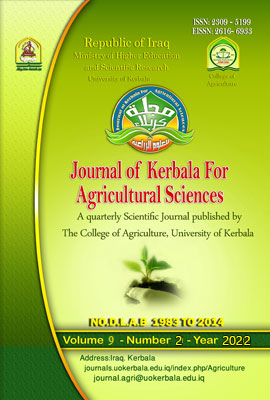Effect of using different levels of nano-zinc oxide with date by products on in vitro digestibility, fermentation characteristics and gas production
DOI:
https://doi.org/10.59658/jkas.v9i2.958Abstract
The experiment was conducted to study the effect of adding different levels of nano zinc oxide (0, 15 and 30 mg) / kg DM to mixture ration consisting of nano-zinc oxide with date by products either 30% date kernel or date peels or mixture (15 date kernel + 15 date peels) to 70% concentrate ration on digestibility, rumen characteristics, total gas and methane gas production. the results showed significant decrease as a result of adding nano-zinc oxide N zno in methane gas production for the treatment 15 and 30 mg/kg, and it reached (16.88 and 15.55 ml/200 mg), and (Date kernel produced significantly more total gas and methane, metabolizable energy (ME), in vitro organic matter digestibility (IVOMD%), and fatty acid short-chain SCFA (45.55, 23.77, 64.14, 11.25, and 1.02), respectively)..( Date kernel produced significantly more total gas and methane, metabolizable energy (ME), in vitro organic matter digestibility (IVOMD%), and fatty acid short-chain SCFA (45.55, 23.77, 64.14, 11.25, and 1.02), respectively. Also, the treatment of adding nano-zinc oxide at the level of 15 mg/kg dry matter significantly was superior to the digestibility factor of dry matter and organic, and it reached 62.29 and 63.96%, respectively, compared to the levels of 0 and 30 mg/kg dry matter and a significant decrease at levels of 0 and 15 mg/kg dry matter, which was 5.31 and 5.15 for pH 26.44 and 30.95 (mg/100ml) for ammonia nitrogen, respectively. whereas significantly increased for the level of 15 mg/kg dry matter, in the total volatile fatty acids and it reached 3.23 (mmol/100ml) after a 24-hour incubation period for the rumen fluid in vitro.
Downloads
Published
How to Cite
Issue
Section
License
Copyright (c) 2022 Copyright (c) 2024 is the Author's article. Published by the Journal of Kerbala for Agricultural Sciences under a CC BY 4.0 license

This work is licensed under a Creative Commons Attribution 4.0 International License.
Licensing Terms
All articles are published under a Creative Commons License and will be directed to the Creative Commons Attribution 4.0 International License (CC BY 4.0) That permits use, distribution, and reproduction in any medium, provided the original work is properly cited. This license also allows the work to be used for commercial purposes.
Use by both non-commercial and commercial users
This content is licensed under a Creative Commons Attribution 4.0 International (CC BY 4.0) license, permitting use by both non-commercial and commercial users. Individual users may access, download, copy, display, and redistribute the articles to colleagues, as well as adapt, translate, and text- and data-mine the content, subject to the following conditions:
- The author's moral rights, including the right of attribution and the right to protect their work from derogatory treatment, are respected.
- Where content in the article is identified as belonging to a third party, users must ensure that any reuse complies with the copyright policies of the owner of that content.
- If the article content is reused for research or educational purposes, users should maintain a link to the appropriate bibliographic citation, including the DOI and a link to the published version on the journal's website.

